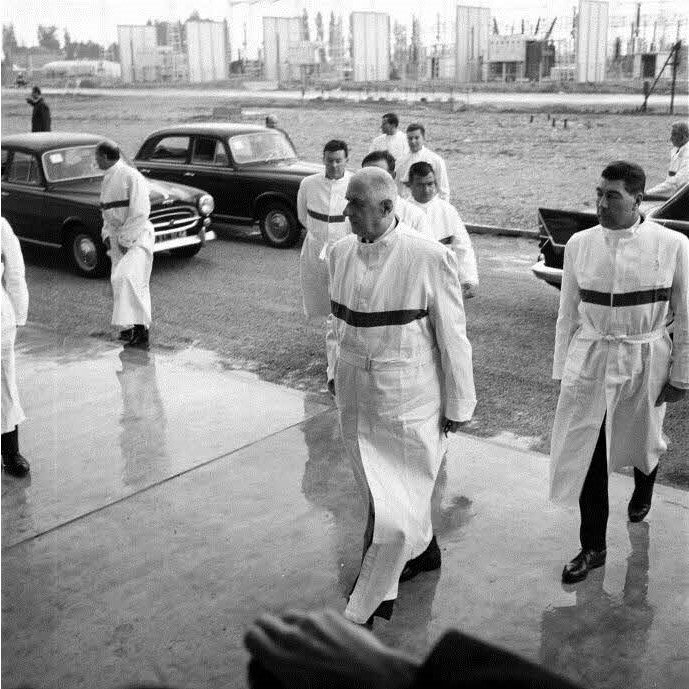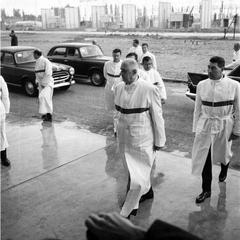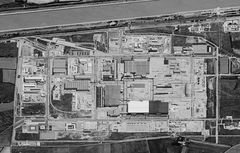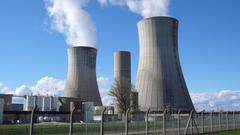
Tricastin Nuclear Site Visiting Hours, Tickets, and Historical Significance in Bollène, France
Date: 15/06/2025
Introduction
Situated near Bollène in southeastern France, the Tricastin Nuclear Site is a pivotal landmark in the French nuclear energy sector. Spanning both the Drôme and Vaucluse regions along the Rhône River, this extensive industrial complex reflects decades of scientific innovation, energy production, and regional heritage. Originating in the territory of the ancient Tricastini tribe, Tricastin has evolved from its early uranium enrichment operations in the 1960s into one of Europe’s premier nuclear power and fuel processing centers (Wikipedia; fr.wikipedia).
France’s drive toward postwar energy independence led to the creation of facilities such as Eurodif and, later, the advanced Georges Besse II enrichment plant. Today, Tricastin encompasses a four-reactor nuclear power plant (operated by Électricité de France, EDF), along with chemical conversion and waste management units managed by Orano and Socatri. This integrated ecosystem demonstrates France’s commitment to nuclear safety, environmental protection, and modern technology (World Nuclear Association; Orano).
While primarily an industrial facility, Tricastin welcomes visitors through educational and guided tours. The surrounding region, rich in culture and natural beauty, offers a range of attractions, from the Parc Naturel Régional du Mont Ventoux to local museums in Bollène and Saint-Paul-Trois-Châteaux. This guide details the site’s history, visiting hours, ticketing, safety guidelines, and travel tips, ensuring an enriching and informative experience (EDF Odyssélec; Les Circuits de l’Énergie).
Table of Contents
- Origins of the Tricastin Region
- Strategic Development and Early Nuclear Operations (1958–1970s)
- Shift to Civilian Nuclear Power (1970s–1980s)
- Visiting the Tricastin Nuclear Site: Hours, Tickets, and Tours
- Key Facilities and Technological Advances
- Safety, Regulation, and Public Engagement
- Regional Attractions and Visitor Resources
- Frequently Asked Questions (FAQ)
- Conclusion and Visitor Tips
- Official Sources and Further Information
Origins of the Tricastin Region
The name “Tricastin” stems from the ancient Ligurian tribe called the Tricastini, who once inhabited the Rhône valley. Their capital, Augusta Tricastinorum, is referenced by Pliny the Elder and lies beneath today’s Saint-Paul-Trois-Châteaux (Wikipedia; fr.wikipedia). This deep historical legacy forms a rich backdrop for the site’s modern technological role.
Strategic Development and Early Nuclear Operations (1958–1970s)
Post-WWII France sought nuclear capability for both military and civilian purposes. In 1958, under General de Gaulle, the Tricastin region was chosen for its strategic location and infrastructure. The Commissariat à l’énergie atomique (CEA) established the site in 1961, initially focusing on uranium enrichment for national defense (fr.wikipedia).
By the early 1960s, facilities like the Société des Usines Chimiques de Pierrelatte (SUCP) and the Usines de Diffusion Gazeuse (UDG) were operational, setting the stage for France’s dual-use nuclear ambitions.
Shift to Civilian Nuclear Power (1970s–1980s)
The 1970s saw France pivot toward large-scale civilian nuclear power. Construction began on the Tricastin Nuclear Power Plant in 1974, with four pressurized water reactors commissioned between 1980 and 1981. Each reactor delivers around 915 MW, making the site a critical supplier of electricity to the French grid and supporting adjacent enrichment operations (Wikipedia; en.wikipedia).
The site’s location along the Donzère-Mondragon canal ensured access to water for cooling and efficient transportation links.
Visiting the Tricastin Nuclear Site: Hours, Tickets, and Tours
Though Tricastin is a secure industrial complex, it provides structured opportunities for public engagement through the EDF Odyssélec visitor center and guided tours by prior arrangement:
- Opening Hours: Monday to Friday; free public access to the EDF Odyssélec exhibition on Wednesdays, 1:00 pm–5:00 pm.
- Guided Tours: Available by appointment for visitors aged 12 and above; tours last about two hours.
- Tickets: Entry to the exhibition is free on Wednesdays; guided tours require advance booking (EDF Odyssélec).
- Accessibility: The visitor center is wheelchair accessible; accommodations for reduced mobility can be arranged with advance notice.
- ID Requirement: Valid photo identification is required for all visitors.
Note: Due to security, spontaneous visits are not permitted. Photography is restricted in operational areas; always follow staff instructions.
For details and reservations, visit the EDF Tricastin visitor page.
Key Facilities and Technological Advances
Uranium Enrichment: From Eurodif to Georges Besse II
The original Eurodif plant, using gaseous diffusion, was a pioneer in uranium enrichment for both military and civilian applications until its closure in 2012. The subsequent Georges Besse II plant (2007–2016) employs energy-efficient centrifuge technology and maintains Tricastin’s global role in uranium supply (World Nuclear Association).
Conversion and Chemical Processing
The Philippe Coste plant converts uranium ore into uranium hexafluoride (UF6), a step essential for enrichment. Orano’s extensive fluorine chemistry expertise ensures Tricastin’s continued relevance in the nuclear fuel market (Orano).
Maintenance and Waste Management
Facilities such as BCOT handle maintenance and storage of contaminated equipment, while Socatri manages waste treatment in compliance with rigorous environmental standards (fr.wikipedia).
Safety, Regulation, and Public Engagement
Tricastin operates under strict regulatory oversight by the French Nuclear Safety Authority (ASN). Notable milestones include the fourth decennial safety review of Unit 1, allowing operation up to 50 years (World Nuclear News; Brussels Signal). The site maintains robust emergency procedures and regularly updates safety protocols in response to regulatory reviews.
Public engagement is promoted through educational programs, local consultation bodies, and visitor initiatives.
Regional Attractions and Visitor Resources
Nearby Cultural and Natural Highlights
- Saint-Paul-Trois-Châteaux: Roman heritage, medieval streets, and local museums.
- Wine and Gastronomy: The region’s vineyards—now labeled Grignan-Les Adhemar—offer tastings and tours.
- Outdoor Activities: The Rhône valley and Donzère-Mondragon canal provide hiking, cycling, and boating opportunities.
- Bollène: Explore the old town, Saint-Martin Church, and local markets (Bollène tourism).
- La Ferme aux Crocodiles: A renowned reptile park in nearby Pierrelatte.
- Château de Barry: Discover regional architecture and panoramic views (Mapcarta).
- Bollène Hydropower Plant: Visit the historic André Blondel station (Les Circuits de l’Énergie).
Visitor Services
- Parking: Free parking for cars and coaches.
- Rest Areas: Green spaces and picnic spots available.
- Amenities: Gift shop, conference rooms, and accessible restrooms.
For further travel planning, see Drôme Tourism Office and Parc Naturel Régional du Mont Ventoux.
Frequently Asked Questions (FAQ)
Q: Can I visit without prior booking?
A: No. All tours require advance registration due to security protocols.
Q: Are tours available in English?
A: Yes, request English-language materials and guides in advance.
Q: Are children allowed?
A: Visitors must be at least 12 years old to participate in guided tours.
Q: What identification is required?
A: A valid photo ID is mandatory for all visitors.
Q: Is the site wheelchair accessible?
A: Yes, the visitor center and main exhibition areas are accessible.
Q: Where can I park?
A: Free parking is available near the visitor center.
Q: How do I get there?
A: The site is accessible by car (A7 motorway), or by regional TER train to Bollène, with connections from Avignon and Valence.
Conclusion and Visitor Tips
The Tricastin Nuclear Site is a symbol of France’s nuclear heritage, technological prowess, and commitment to safety and environmental stewardship. While industrial access is tightly regulated, the visitor experience is rich—offering guided tours, interactive exhibits, and access to the broader cultural and natural treasures of the Drôme and Vaucluse regions.
Plan your visit:
- Book tours in advance through official channels.
- Check for public opening times and special events on the EDF Odyssélec website.
- Download the Audiala app for updates, exclusive content, and regional travel tips.
Whether you are fascinated by science, history, or regional culture, Tricastin and its surroundings offer a memorable and educational journey.
Sources and Official Links for More Information
- Wikipedia
- fr.wikipedia
- World Nuclear Association
- Orano
- World Nuclear News
- Brussels Signal
- Wise Uranium – Tricastin Site Overview
- Orano Official Website
- Drôme Tourism Office
- Parc Naturel Régional du Mont Ventoux
- Euronuclear
- NucNet
- EDF Odyssélec
- Les Circuits de l’Énergie
- Mapcarta
- EDF Tricastin visitor page
- Bollène tourism website



